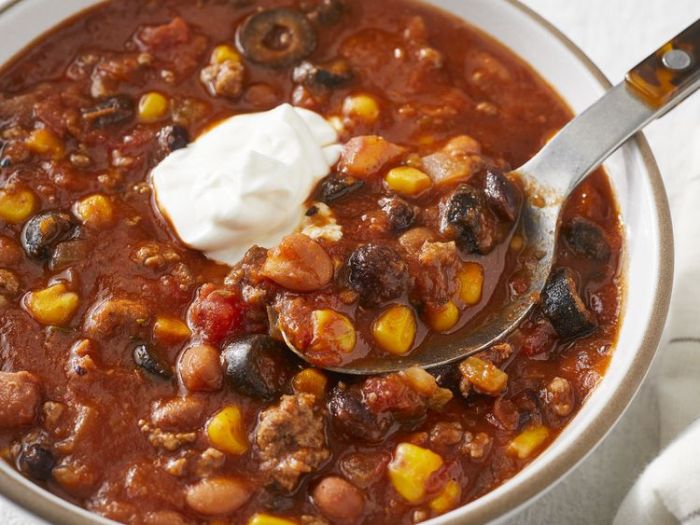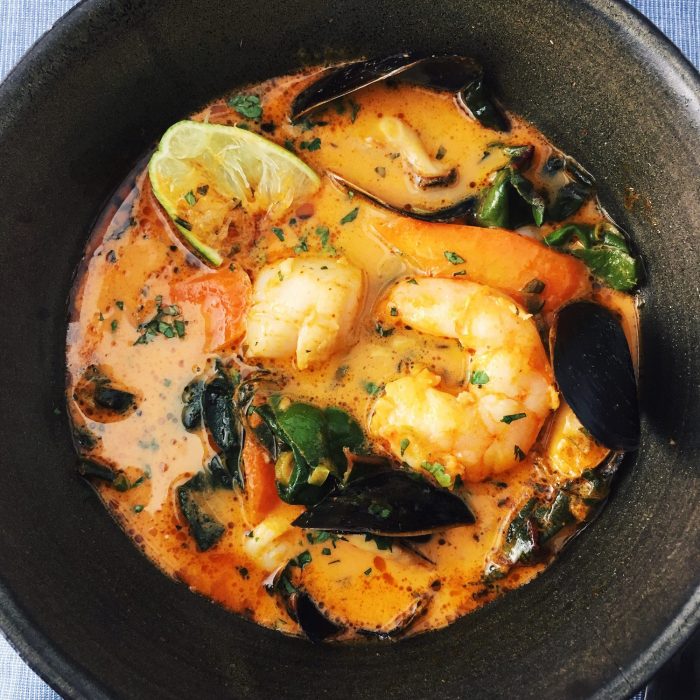Potato Bacon Cheese Soup: Recipe Variations and Cooking Guide: Potato Bacon Cheese Soup Recipe
Potato bacon cheese soup recipe – This article delves into the versatile world of potato bacon cheese soup, offering variations, ingredient considerations, cooking techniques, serving suggestions, and troubleshooting tips. We’ll explore different potato types, bacon choices, cheese options, and cooking methods to help you create the perfect bowl of creamy, comforting soup.
Recipe Variations
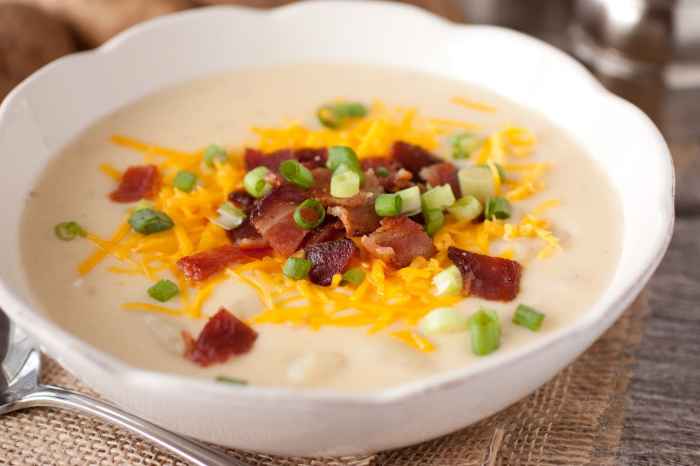
Source: cookingclassy.com
This section explores several variations of the classic potato bacon cheese soup recipe, catering to different tastes and dietary needs. We’ll showcase variations using different potato types, a vegetarian option, a spicy version, and a low-sodium alternative.
- Russet Potato Variation: Russet potatoes, known for their fluffy texture and mild flavor, create a hearty and creamy base. Their starchy nature contributes to a thicker soup.
- Yukon Gold Potato Variation: Yukon Gold potatoes offer a buttery flavor and slightly waxy texture, resulting in a smoother, richer soup. Their sweetness complements the savory bacon and cheese.
- Red Potato Variation: Red potatoes add a touch of earthiness and hold their shape better than russets, providing a slightly chunkier texture in the soup.
- Vegetarian Adaptation: Substitute the bacon with crispy fried mushrooms or pan-fried tempeh for a delicious vegetarian alternative. The earthy flavors of these substitutes pair well with the potatoes and cheese.
- Spicy Version: Incorporate 1-2 finely chopped jalapeños (for mild heat) or a ½-1 serrano pepper (for medium heat) along with the onions during the initial sautéing stage. For a spicier kick, add a pinch of cayenne pepper.
- Low-Sodium Version: Use low-sodium bacon or omit it altogether. Reduce the amount of salt used throughout the recipe and consider using reduced-sodium chicken broth or vegetable broth. Instead of heavily salted cheese, opt for a milder cheese with less sodium content.
Ingredient Sourcing and Preparation
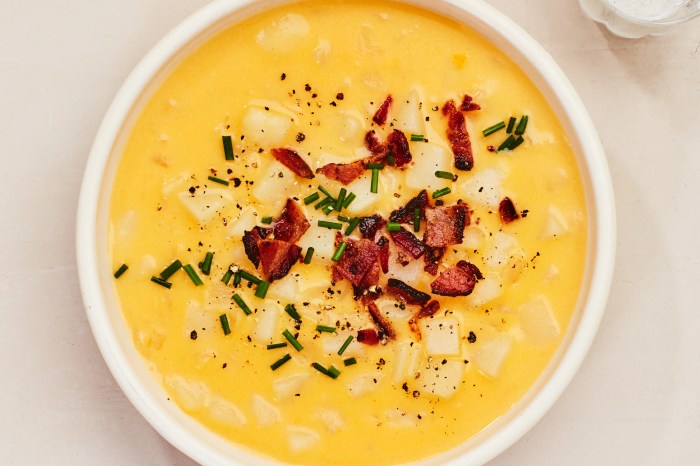
Source: epicurious.com
The quality of your ingredients significantly impacts the final taste of your potato bacon cheese soup. This section provides guidance on selecting the best ingredients and preparing them correctly.
Selecting the right potatoes is key. Russet potatoes, with their fluffy texture and mild flavor, are a classic choice. Yukon Golds offer a buttery flavor and smooth consistency, while red potatoes provide a firmer texture and subtle earthiness. Thick-cut bacon with a good balance of fat and smokiness is ideal. Consider using a hardwood-smoked bacon for enhanced flavor.
For the cheese, choose a melting cheese like cheddar, Gruyere, or a blend of your favorites. Cheddar offers a sharp taste, Gruyere a nutty complexity, and blends provide a more balanced flavor profile.
- Bacon Preparation: Cook the bacon in a large skillet over medium heat until crispy. Remove the bacon with a slotted spoon, reserving the bacon fat in the pan. Crumble the bacon and set aside.
Cooking Methods and Techniques
This section compares stovetop and slow cooker methods and explains the soup’s thickening process.
The potato bacon cheese soup can be prepared using two primary methods: stovetop and slow cooker. The stovetop method offers more control over the cooking process, allowing for adjustments in consistency and seasoning. The slow cooker method requires less hands-on time, resulting in a tender and flavorful soup.
A creamy potato bacon cheese soup recipe is a comforting classic, easily customizable to your taste. For a similar, restaurant-quality experience, you might consider checking out the outback steakhouse baked potato soup recipe for inspiration; its robust flavor profile could inform your own creation. Ultimately, though, a successful potato bacon cheese soup hinges on the quality of your ingredients and your personal touch.
Thickening the soup: The soup thickens naturally as the potatoes cook and release their starches. If the soup is too thin, simmer it uncovered for a longer period to reduce the liquid. Alternatively, you can create a roux (a mixture of butter and flour) and whisk it into the soup for a thicker consistency. For a creamier texture without heavy cream, use milk or half-and-half, or even blend a portion of the cooked soup before returning it to the pot.
Visual Representation of Cooking Stages: Initially, the soup is a vibrant mix of translucent onions and potatoes. As it simmers, the potatoes soften and become opaque, releasing their starches. The color deepens slightly, and the texture transforms from chunky to creamy. The final soup is a rich, golden hue with visible pieces of bacon and cheese.
Serving Suggestions and Presentation
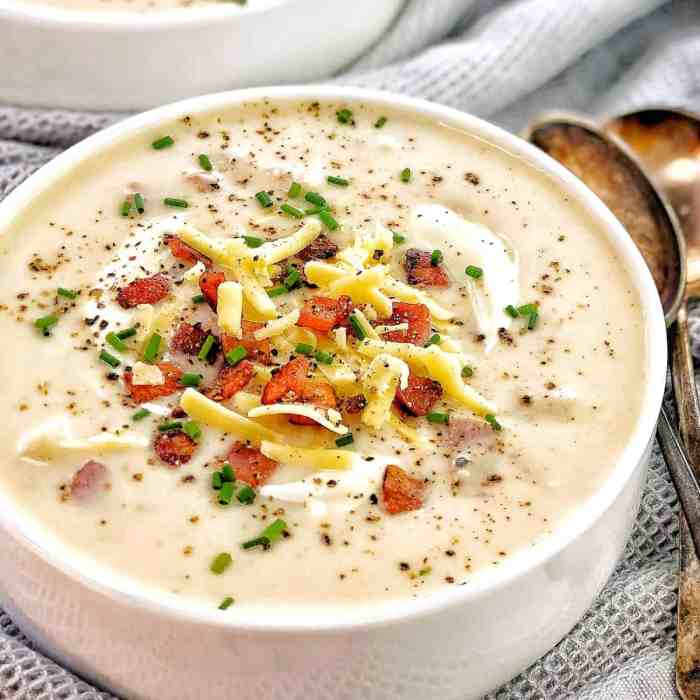
Source: chefnotrequired.com
This section provides creative serving suggestions and garnishes to enhance the visual appeal and flavor of your potato bacon cheese soup.
Garnishes can elevate the soup’s presentation and flavor. Consider crumbled bacon, a sprinkle of fresh chives, or a dollop of sour cream or crème fraîche. These additions provide visual interest and complementary flavors.
- Serve with crusty bread: The bread soaks up the delicious soup, creating a satisfying and complete meal.
- Pair with a side salad: A fresh green salad balances the richness of the soup, adding a light and refreshing element.
- Serve with grilled cheese sandwiches: This classic pairing creates a comforting and indulgent meal.
| Nutritional Information (Per Serving) | Calories | Fat (g) | Protein (g) | Carbohydrates (g) |
|---|---|---|---|---|
| Placeholder Data | 350 | 20 | 15 | 30 |
Serving the soup hot is ideal, as this enhances its creamy texture and allows the flavors to fully develop. A warm temperature accentuates the savory notes of the bacon and cheese, and the comforting warmth of the potatoes.
Recipe Troubleshooting and FAQs, Potato bacon cheese soup recipe
This section addresses common mistakes and frequently asked questions to ensure your potato bacon cheese soup is a success.
Common mistakes include overcooking the potatoes, resulting in a mushy texture, and under-seasoning the soup. Overcooked potatoes can be remedied by carefully blending a portion of the soup to create a creamier consistency. Under-seasoning can be adjusted by adding salt, pepper, or other spices to taste.
- Leftover Storage: Store leftovers in an airtight container in the refrigerator for up to 3 days.
- Frequently Asked Questions:
- Q: Can I use other types of cheese? A: Yes, experiment with different cheeses like Gruyere, Monterey Jack, or a blend.
- Q: How can I make the soup spicier? A: Add chili flakes or chopped jalapeños.
- Q: What if my soup is too thin? A: Simmer it uncovered or make a roux to thicken it.
- Q: What if my soup is too thick? A: Add a little broth or milk to thin it out.
User Queries
Can I use leftover cooked bacon?
Yes, leftover cooked bacon works perfectly. Just ensure it’s crispy before adding it to the soup.
What if my soup is too thin?
Simmer the soup uncovered for a longer period to reduce the liquid. Alternatively, you can thicken it with a cornstarch slurry (mix cornstarch with cold water before adding).
What if my soup is too thick?
Add a little broth or milk to thin it out to your desired consistency.
How long can I store leftover soup?
Store leftover soup in an airtight container in the refrigerator for up to 3-4 days.
Can I freeze this soup?
Yes, this soup freezes well. Allow it to cool completely before freezing in airtight containers for up to 2 months.

